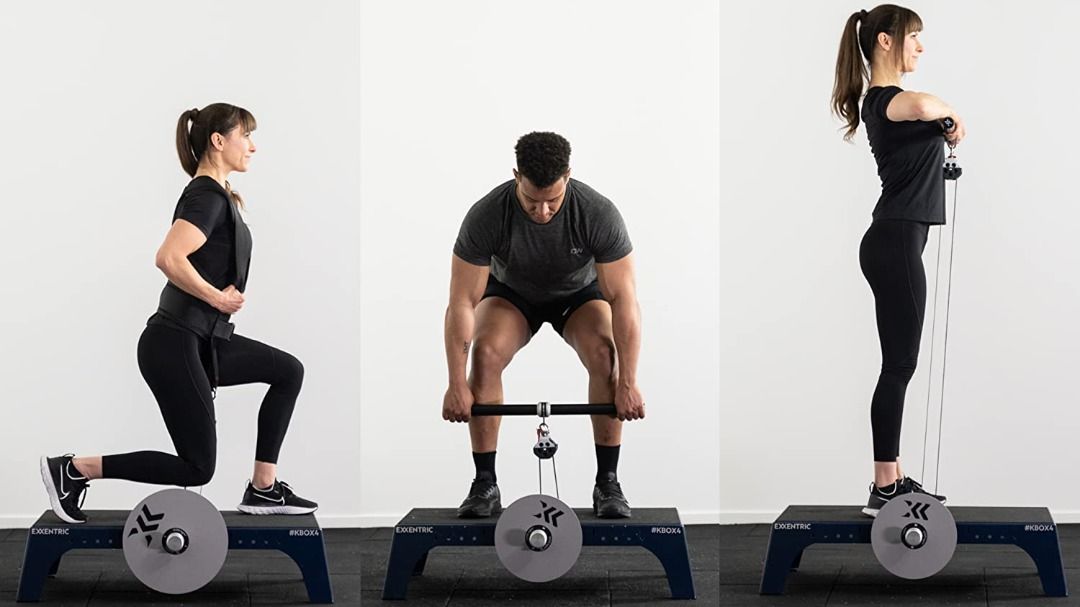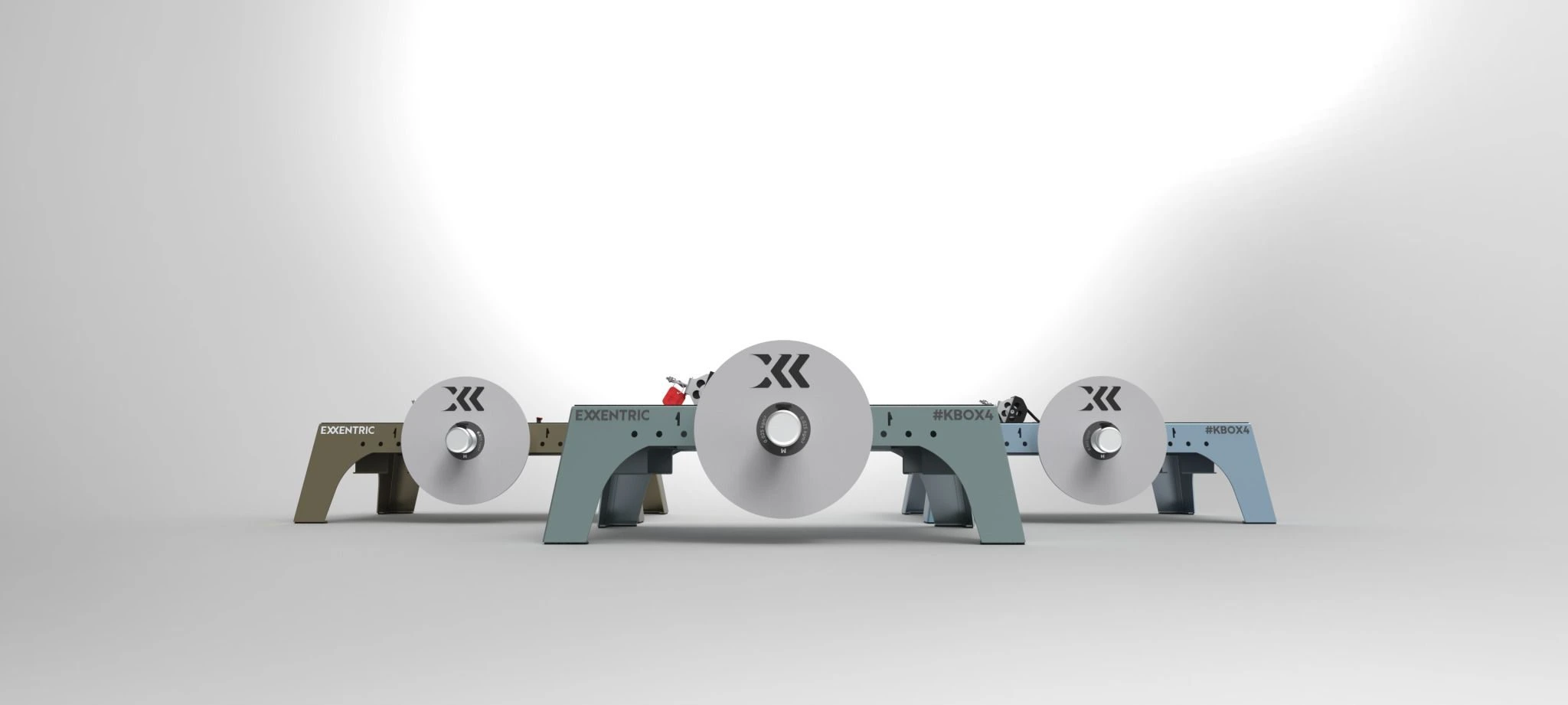Contents
- Introduction
- What is a KBOX?
- What does a KBOX do?
- How does KBOX work?
- Is KBOX worth it?
- How do I set up KBOX?
- Conclusion
Introduction
The kBox is a flywheel training device that is in its fifth generation of development since its inception in 2011-12. The platform-based flywheel device offers a range of exercises to be performed in the gym (e.g. squats, hinges, rows), and is portable to travel wherever necessary (e.g. pitch, home gym, or hotel). The action of the flywheel provides a training experience that is truly unlike any other, and the physical benefits of increasing strength and hypertrophy are well-researched (1). Ultimately, for individuals looking to maximise their time and results with training, the novel stimulus allowed with the kBox can be a difference maker for athletes aiming to gain an edge regarding performance enhancement and injury resilience.

What is a KBOX?
A kBox is a platform-based flywheel training device designed by Exxentric. The platform allows users to stand atop and push against in order to perform a variety of exercises (e.g. squat, hinge, calf raise, row, etc.). Users will actively push or pull (i.e. apply force) to a strap attached to a handle, bar, or belt that works against a rotating flywheel as resistance. Essentially, the kBox is a platform-based flywheel training device designed by Exxentric that has gone through five versions of advancements in the last twelve years.
Exxentric is arguably the leader in the resurgence of flywheel training for fitness and athletic development over the last decade. Fredrik Correa and Marten Fredriksson founded their company in 2011 after identifying a need for a more practical and efficient training tool while working with youth ice hockey players (2). Over the last decade, the kBox has continued to evolve into the premiere option for a variety of exercises using flywheel technology. It has been researched as an alternative to free weight exercises and continues to surface as a worthwhile training means that matches or exceeds the gains experienced with traditional free weight training (3). Ultimately, the stimulus experienced with a flywheel provides a meaningful stimulus that may benefit the athlete, team, or individual you work with.
The use of flywheel devices in training dates back to the late 1700s (Gymnasticon, 2). Flywheels were used in the early 1900s for exercise physiology research and gained the strongest support in the 1990s as a training means for astronauts aiming to limit muscle and bone loss during zero-gravity space travel (2). The training experience and opportunities to load various movement patterns (e.g. squat, leg extension, etc.) through the inertia and kinetic energy generated in a flywheel provided a practical option that exposes muscles to the necessary resistance (i.e. mechanical tension) to support maintaining strength and muscle mass (2).
With the kBox, Exxentric took the approach of training astronauts in space to training athletes in the gym, on the court, or at the pitch. With a much more favourable environment, flywheel training provides substantial increases in strength and muscle mass (1). Through Exxentric’s advancements over the years, the kBox has become a versatile, portable, and practical option for a range of athletes to at-home exercise enthusiasts.

What does a KBOX do?
The kBox creates resistance through the rotation of weighted wheels that generate inertia based on the momentum generated during the concentric (upward) action of a movement (1). What is special about the kBox and flywheel training is that the design and materials used allow for the resistance to match the effort of the user. For example, however hard the athlete works (pushes or pulls) through the concentric action, the axle will continue to rotate and recoil the strap with the same energy that was generated. Hence the term, ‘isoinertial,’ where the load is constant due to the inertia generated by the user and kinetic energy built in (1).
Based on the strategies used during the concentric and eccentric portion, there is opportunity to experience an eccentric overload either by a delayed reception of the inertia on the eccentric side (lengthening portion of the movement), or an accentuated concentric action through assistance or a stronger position. For example, if an athlete is squatting on the kBox, and pushes with maximal effort throughout the full range of motion (especially in the top portion of the squat where it becomes more advantageous, and the user is able to generate more energy in the wheel). As the strap recoils, the athlete can move into a deeper squat position to brake and redirect the rotating flywheel. Given the additional energy built as the athlete accelerates up, there is potential for eccentric overload to be experienced at the bottom. This ‘overload’ has been shown to help build muscle, strength, and resiliency (5).
How does KBOX work?
Resistance training typically works with external loads and gravity (e.g. barbells, dumbbells, etc.), whereas the kBox uses inertia generated in the flywheel to create resistance similar to a yoyo. The thing to recognize is that whatever energy is generated on the way up/out (as the strap uncoils) will be returned on the way down/in (as the strap recoils). Additionally, users can use larger wheels to reduce the speed of movement and increase the amount of inertia to overcome when performing various exercises.
Due to the rotating wheel, there is a cyclical action to repetitions that is unlike any other form of resistance training. The greatest levels of tension or generated while the muscles are at their longest length, which is an aspect beneficial to increasing hypertrophy and durability for athletes aiming to do so (4).
Due to the rotating wheel, there is a cyclical action to repetitions that is unlike any other form of resistance training. The greatest levels of tension or generated while the muscles are at their longest length, which is an aspect beneficial to increasing hypertrophy and durability for athletes aiming to do so (4).
Given the fact that the resistance is generated by the user, the ‘variable resistance’ provided aims to maximise each repetition from the start (given the effort level of the user is maximal), and tapers to match the effects of fatigue. This allows sets to be extended further than typical mass-based resistance that remains constant. Therefore, it allows athletes to accumulate more stimulatory repetitions in a set, volume in a session, and possibly better skill and performance development.
Regarding performance metrics, the kMeter (which measures flywheel rotations) provides live, rep by rep, feedback (2). Users are able to see concentric/eccentric power, range of motion, forces produced (concentric) or yielded (eccentric), eccentric overload achieved, and energy expended for each repetition (5). This insight is useful for making training decisions and tracking progress similar to velocity-based training, these metrics provide the user with a target to achieve and can help to dictate the number of reps in a set, and sets in a given session.

Is KBOX worth it?
Given the practicality and novelty of a kBox, I would suggest considering incorporating it into your training regime. The advancements over the last decade have made it a durable and efficient system that is able to adapt to numerous exercises (e.g. squats, hinges, rows, etc.)
Likewise, for athletes with limited training space (e.g. garage gym, on field, or travelling), they can accomplish a good amount of primary complex movements with minimal equipment and adjustments.
Therefore, if the budget allows, I think a commitment and exposure to flywheel training can be a beneficial exposure to maximising the return on strength, hypertrophy, rehabilitation, and resiliency training.
Further, there are a range of kBox options available (e.g. kBox Active, kBox Lite, kBox Pro, etc.) that vary in price (2). This allows users to find the model that best fits their needs at an affordable price.
How do I set up KBOX?
The kBox is easy to set up, has minimal moving parts, and has great support in navigating any technical issues from Exxentric (2). The advancements in materials and interaction of parts have greatly improved over the last ten years. With the most recent rollout of the fifth generation kBox, it is arguably better than ever. The set-up process is as simple as attaching the desired attachment (e.g. belt, harness, handle), adjusting the strap to the appropriate length, deciding appropriate load, and executing the movement to ensure that the box remains stable. All in all, the kBox provides the user with a great experience that leaves them better physically but also mentally encouraged to be consistent day to day and week to week throughout training.

Conclusion
As with the investment of any training device, there is a filter of questions that a coach and athlete must go through to decide whether the return is worth the investment. Given the consistent training benefits shown in flywheel research, that is reason enough for me to consider implementing it into training for any athlete, regardless of sport or training age (6 & 7). Flywheel training with the kBox is adaptable to the individual’s ability. Not to mention, it is versatile and portable. The exercise prescription and progression is really only limited by the imagination of the individual. Lastly, the price for the quality and durability is justifiable as well. As the saying goes, ‘you get what you pay for’ and I think for the price, the cost definitely outweighs the benefits. The kBox provides unique opportunities that could be the difference maker in an individual’s ability to be stronger, faster, and more durable.
- Beato, M., & Dello Iacono, A. (2020). Implementing flywheel (isoinertial) exercise in strength training: current evidence, practical recommendations, and future directions. Frontiers in physiology, 11, 569. [Link]
- History: Exxentric: Flywheel training. Exxentric. (2023, October 31). [Link]
- Wonders, J. (2019). Flywheel training in musculoskeletal rehabilitation: a clinical commentary. International journal of sports physical therapy, 14(6), 994. [Link]
- Pettitt, R. W., Symons, J. D., Eisenman, P. A., Taylor, J. E., & White, A. T. (2005). Repetitive eccentric strain at long muscle length evokes the repeated bout effect. The Journal of Strength & Conditioning Research, 19(4), 918-924. [Link]
- Maroto-Izquierdo, S., García-López, D., Fernandez-Gonzalo, R., Moreira, O. C., González-Gallego, J., & de Paz, J. A. (2017). Skeletal muscle functional and structural adaptations after eccentric overload flywheel resistance training: a systematic review and meta-analysis. Journal of science and medicine in sport, 20(10), 943-951. [Link]
- Petré, H., Wernstål, F., & Mattsson, C. M. (2018). Effects of flywheel training on strength-related variables: A meta-analysis. Sports medicine-open, 4, 1-15. [Link]
- Raya-González, J., de Keijzer, K. L., Bishop, C., & Beato, M. (2022). Effects of flywheel training on strength-related variables in female populations. A systematic review. Research in Sports Medicine, 30(4), 353-370. [Link]



